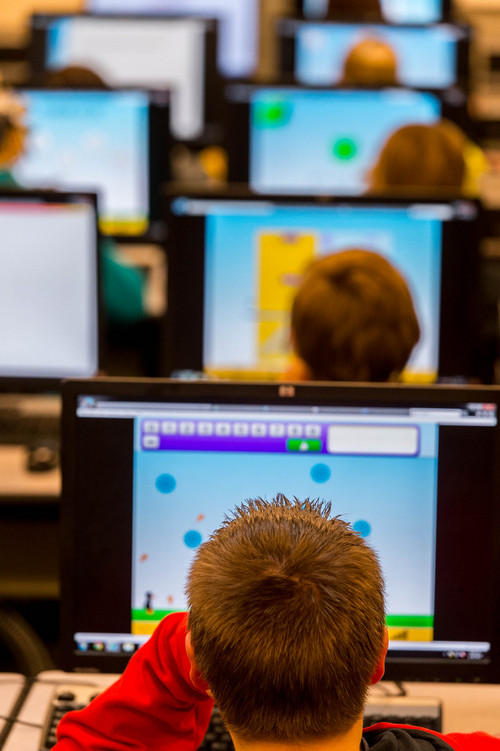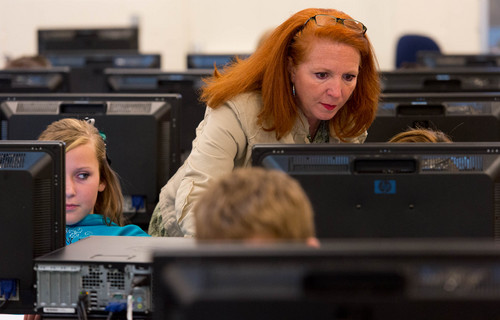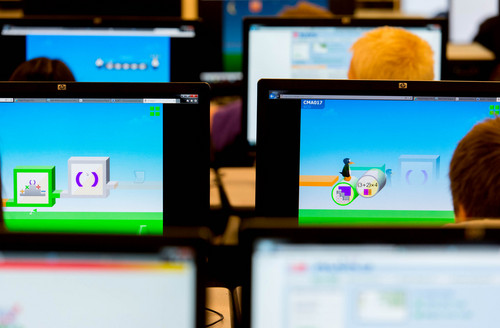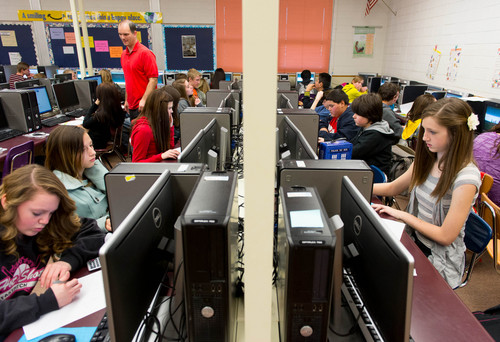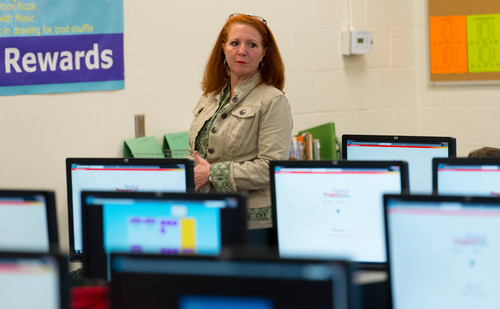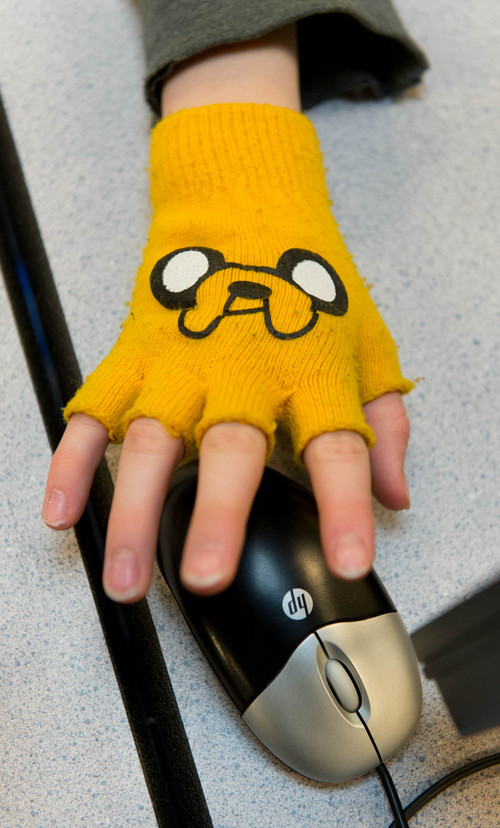This is an archived article that was published on sltrib.com in 2014, and information in the article may be outdated. It is provided only for personal research purposes and may not be reprinted.
Seventh-grader Michael Hernandez is loving the new ThinkThroughMath software that his math teacher in Logan uses once a week to supplement her math lessons.
Hernandez likes how it displays formulas and fills gaps in his knowledge, and he especially thrives on the competition built into the program. For a brief time last fall, the 13-year-old was in second place behind a buddy among all seventh-graders using ThinkThroughMath in Utah.
But ask Hernandez if his success in math this year is due to the software, piloted through Utah's new STEM Action Center, or his teacher at Bear River Charter School, and he pauses.
It's not either-or.
"I have a really good teacher. She stays after school for anything I have trouble with," he says. "But ThinkThroughMath has a bit to do with it, too."
It's both.
That's the kind of anecdotal evidence for the software's usefulness that is flowing into the center, based in the Governor's Office of Economic Development, after a two-month pilot project.
More than 5,500 students in 40 schools were assessed before, during and after using one of a dozen software programs and against control groups who did not use any software. (Most of the schools are still using the technology, though the formal pilot is over).
The point was to identify — and then deploy — new software that can help schools improve their middle- and high-school math scores, using $8.5 million budgeted by the Legislature last year.
Data from the pilot are expected out this month from researchers at Utah State University and more complete data after end-of-year tests.
But even without the final data, committees of educators working with the STEM Center in December chose seven software programs that will be offered next year, via grants, for sixth through eighth grades and five for high schools.
The 40 pilot schools will have first dibs on the software, which will be demonstrated in the spring during four "road shows" around the state, says Meredith Mannebach, program manager for the center. Other schools also will be able to apply.
The goal is to reach 25 percent of the state's students in grades six through 12 with new math software next year, says Tami Goetz, the former state science adviser who is taking a leave of absence from Utah Valley University to serve as the STEM center's director.
The STEM Center, placed in the state's economic development arm because legislators wanted business to play a role in educating tomorrow's workforce, is zeroing in first on math because it's fundamental and because so many Utah students graduate high school unprepared for college math.
Gov. Gary Herbert is seeking $3 million more for the STEM Action Center in next year's budget.
Math, says Goetz, "is the gorilla in the room."
—
'Students are moving ahead' • Seventy seventh- and eighth-graders sit in front of Internet-connected computers at Tooele Junior High School, each working at his or her own pace.
One eighth-grader adds and subtracts negative fractions with unlike denominators. When she gets a wrong answer, the program shows where she went wrong and demonstrates the right way to solve the problem.
The next student is using ST Math, a program Tooele Junior High has found especially useful for English-language learners, for those who need remedial math or have trouble reading. It uses only pictures and numbers, no words.
Students essentially play math games, solving addition, subtraction and fraction problems that are presented in pictures, such as flowers or peanuts. When they succeed, Jiji the penguin walks across the screen.
"It gives them the ability to move from concrete to abstract," says Karen Sandberg, a special-education teacher.
All 850 students in the school were involved in the pilot, and still spend two of their five math periods each week in a computer lab, working with the new software. (A third day is also in the lab, working with another software program.)
Eighth-grade teacher Brent Larsen likes that self-starter students can go as fast and as far as they like on ALEKS. And he has more time for students who need to be shown that learning can be fun.
At any moment during or after class, he gets a report on his computer screen of the percentage of students who have mastered particular concepts — and who are having trouble. That helps him know which concepts to emphasize when his students are back in the regular classroom.
Katherine Anderson, who teaches seventh- and eighth-graders, says ALEKS is "a great program."
But it has not been easy to give up two periods of teaching each week, she says.
"I'd like more time in the classroom," she says, "to make sure they got the concepts I taught and to practice."
Indeed, Lisa Johnson, the head of Tooele Junior High's math department, says that's one of the chief difficulties in using technology.
Teachers are evaluated by how well their students perform on end-of-year tests on the Utah Common Core. So giving up 40 percent of their classroom time to software instruction has been "scary," she says.
Whether it's worth it, Johnson says, is not yet clear. "I know the kids are learning and filling in holes. All students are moving ahead."
David Winkler, a math teacher at Dual Immersion Academy, a charter school in Salt Lake City, says his students seem to love ST Math because it's interactive and gamelike.
It may be hard to isolate the source of improved math scores at the end of the year, he says. "I think overall, it's helping them."
—
Adding support for math • Diana Suddreth, the STEM coordinator for grades seven through 12 at the Utah Office of Education, says the new software grants are not the only initiative to improve math education.
It's increasingly important because students often begin slipping behind in math in middle school. Moreover, the new Utah Common Core demands a more rigorous curriculum than in the past, she says. Some concepts previously taught in ninth grade are now taught in seventh, such as algebra.
To help educators prepare, the state office offers professional-development money to districts and stages a "Core Academy" for teachers in the summers.
The Legislature also appropriated money for a new textbook, Utah Middle School Math, which is being developed by educators from the state's higher education institutions. It's being piloted in the Juab, San Juan and Granite districts.
One problem the STEM Center's pilot has exposed, she says, is the lack of infrastructure in many schools.
At Tooele Junior High, for instance, there were not enough computers for all 850 students to get two more hours a week in a lab. The STEM Center helped connect the school to the company IM Flash, which recently donated 70 refurbished computers and new monitors and keyboards for a second computer lab.
As Suddreth sees it, the STEM Center's $8.5 million math software project has a twofold value. It helps schools buy technology they otherwise couldn't afford and does the research to vet programs.
"There are a lot of products out there," she says, "and knowing which one is helpful is really important for teachers."
Back in Logan, Hernandez's mother — USU Dean of Education Beth Foley — is sold on the idea of using technology to supplement math instruction.
It's great for students to practice and allows teachers to work with small groups, she says. Also, it allows accelerated students to progress as far as they can.
But it's not everything.
"Sometimes people see it as having more power than it does," she says. "There is no program as good as a great teacher." —
State buying software
Ten software companies will get pieces of the $8.5 million that the 2013 Legislature designated for new math software in Utah's middle and high schools. The companies were picked by committees of the new STEM Action Center after a pilot project in the fall. Here are the companies, listed with their software names (if different). Those with asterisks were piloted; others were picked because they've been successful in other states.
For Sixth-Eighth Grades:
Curriculum Associates (i-Ready)
*Mind Research Inst. (ST Math)
Explore Learning (Reflex)
Compass Learning (Odyssey)
Hot Math (Catchup Math)
For Ninth through 12th Grades:
Carnegie (Cognitive Tutor)
Pearson (MathXL for School)
*The NROC Project (EdReady)
Hot Math (Catchup Math) —
More money for STEM
The 2014 Legislature will be asked to put more money into educating Utah's students in STEM (science, technology, engineering and math) subjects.
Gov. Gary Herbert's budget requests $3 million more for the STEM Action Center, created last year as part of the Governor's Office of Economic Development.
Sen. Stephen Urquhart, R-St. George, proposes in SB107 to give school districts $5 million to buy interactive, Web-based programs to teach math in kindergarten through sixth grade.
Urquhart also has said he wants to change math classes in high schools so that more students are ready for college math.
His bill is not yet written, but Urquhart says one goal is to give teenagers an incentive to complete Math 1050 — College Algebra — before they graduate high school. That could take the form of scholarships to Utah institutions of higher education.


